There are three factors that cause caries: “bacteria (Streptococcus mutans)”, “tooth quality”, and “carbohydrates”. When these three factors coexist, caries occur with the passage of time. The presence of just one or two of these three factors will not cause caries.

-
- The cause of caries is the combination of carbohydrates, bacteria, and tooth quality. If you consume sweet foods or drinks often, your mouth will have an environment that is more likely to cause caries.
- If the symptoms progress, you may lose your tooth; so try to receive appropriate treatment at an early stage.
Causes of Caries
Streptococcus mutans, which causes caries, adheres to the teeth and produces plaque, metabolizes carbohydrates contained in food (sugar in particular) and produces acid inside plaque. This acid dissolves the calcium or phosphorus that composes teeth, causing caries.
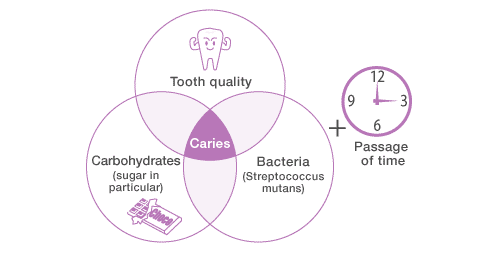 Causes of Caries
Causes of Caries
Bacteria (Streptococcus mutans), tooth quality, carbohydrates
Bacteria (streptococcus mutans)
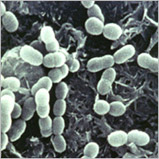 Bacteria (streptococcus mutans)
Bacteria (streptococcus mutans)
Streptococcus mutans is a bacterium with a size of approximately 1 μm (1/1000 mm). It creates acid from carbohydrates and dissolves teeth.
Tooth Quality
Tooth quality differs in each individual, depending on the environment in which the teeth form or other factors. In order to develop strong teeth, a well-balanced diet taking, in nutrients including quality proteins that create the foundation of teeth, calcium and phosphorus necessary for mineralization, and vitamins (A, C, D) necessary for these nutrients to function well, is important.
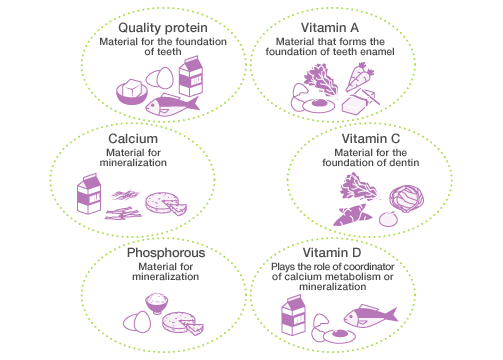 Nutrients that Develop Teeth and Examples of Food Containing Them in Large Amounts
Nutrients that Develop Teeth and Examples of Food Containing Them in Large Amounts
Carbohydrates
Carbohydrates contained in food (sugar in particular) are metabolized by Streptococcus mutans and produce acid. This acid dissolves the tooth surface, which leads to the development of caries. In particular, those who snack often or frequently consume sweet candies or drinks expose their teeth to acid for long periods of time, making their teeth more susceptible to caries.

-
“Function of the saliva”
Saliva has a function of cleansing the mouth and exhibits an antibacterial action against pathogenic microorganisms. In addition, the mouth has a function to restore the tooth surface that has been dissolved by acid (remineralization). Mixing saliva and food well by chewing many times is very important for maintaining and increasing dental health.
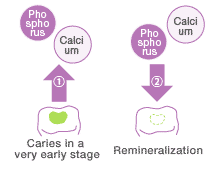 Remineralization
Remineralization
Stages of Caries
 CO (early caries)
CO (early caries)
Although no hole has developed, the surface of the tooth has been dissolved, causing the tooth to lose its luster and to look opaque. This is the “early caries” stage, from which caries begins progressing. In this stage, caries can be reversed through self-care.
| Early caries (reversible through self-care) | |
 |
CO (early caries): one step before caries Although no hole has developed, the surface of the tooth has been dissolved, causing the tooth to lose its luster and to look opaque or light-brown. [Symptoms] There are no subjective symptoms, including pain. * During this stage, teeth can be restored to a healthy state through remineralization. |
| Caries (requires treatment) | |
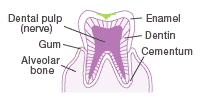 |
C1 (caries in the enamel) A hole develops in a small limited area of the enamel [Symptoms] No pain or sensitivity |
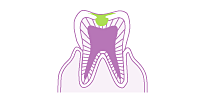 |
C2 (caries reaching the dentin) Caries has spread inside the tooth, reaching the dentin [Symptoms] Sensitivity to cold |
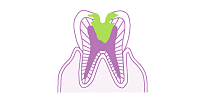 |
C3 (caries reaching the dental pulp) Caries has reached the dental pulp (nerve) The hole on the tooth surface is not necessarily large, but can be spreading within [Symptoms] Severe pain |
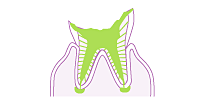 |
C4 (caries leaving only the tooth roots) Caries has caused almost the entire tooth crown (the visible part above the gum) to collapse, leaving only the tooth roots [Symptoms] The dental pulp (nerve) is dead, and the tooth cannot feel pain The dental pulp is exposed, and if it is infected by bacteria, the tip of the roots may become filled with pus or painful If left untreated, it will become a focal point that damages the overall health of the body However, caries is hard to treat at this stage, and usually results in the extraction of the tooth |
![Mechanism of Caries [Caries]](image/h1_self_02.gif)